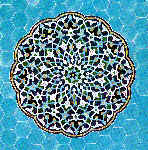
|
Ardakan is on Tehran-Bandar Abbas road, 60 km to the west of Yazd province, and on the margin of Salt Desert. Ardakan's climate is desert but on the high lands, it is relatively temperate.

Historical Relics and Buildings: It is relayed that in the 13th century AD, Ardakan's foundation was laid in Zardak area (whose ruins may still be visited in a place 10 km from the present-day Ardakan). The only building that has remained relatively intact to date is the dome of the old city’s mosque. The existing historical buildings found in the present location of the city mostly date back to three to six centuries ago. Zardak Mosque, which has a niche with very beautiful plaster works, is believed to have been connected by a burrow to Kachip Mosque and there to Meibod's Narin Castle. No trace of this underground tunnel is found today. Ardakan monuments: - Congregational Mosque - Zirdeh Mosque - Kachip Mosque - New Bazaar - Tekieh - Mir Said Mohammad's Shrine - Said Nouroddin's Shrine - Mir Shamsulhaq's Shrine - Dourah and Anbar Castle water cellarage - Molla Aref's Gravestone Zoroastrian: There are numerous Zoroastrian religious sites in Ardakan. Some of them dating back to many centuries ago, including: -Shrines of Pir Shah Eshtad Izad, Pir Shah Tashtar Izad, Pir Shah Mehr Izad, Pir Shah Morad, Pir Shah Fereidoun. All of these (pirangahs) namely the Shrines of religious sages, are in Sharif-abad, a village close to Ardakan. - Shrine of Pir Harisht, located 11 km from Ardakan. - Shrine of Pir Sabz Chek Chek, located on Ardakan-Anjireh heights, in a distance of 50 km from Yazd. Zoroastrians from around the world gather in this Shrine from June 23-27, each year for pilgrimage and alms giving. - Pars Banou's Shrine, in Zarjou valley, is a very revered religious site wherein Zoroastrians gather from across the country from July 10-15 each year for pilgrimage.
|
© Copyright Caroun.com. All rights reserved.